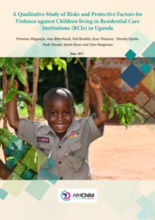Demographic Data
|
Sources: World Bank, UNICEF, UNDP HDR 2015, DHS 2011 |
Displaying 9401 - 9410 of 14391
This report presents the findings of an investigation on a cohort of highly vulnerable teens (aged 10-17 years) whose needs for care have fallen outside families, between government agencies and between non-government services. The report identifies the gaps in care received by this cohort and offers key recommendations for how these gaps might be filled.
This qualitative study of risks and protective factors for violence against children living in
Residential Care Institutions (RCIs) for children is part of the wider qualitative study on violence
against children in Uganda. The study complements the national wellness survey that sought to
measure the prevalence of violence against children in household, schools and the community from
a quantitative perspective
This survey provides a unique source of data and information, covering more than 80 indicators in the areas of nutrition, child health, water and sanitation, reproductive health, child development, literacy and education, child protection and HIV/AIDS.
This survey provides a unique source of data and information, covering more than 80 indicators in the areas of nutrition, child health, water and sanitation, reproductive health, child development, literacy and education, child protection and HIV/AIDS.
This report is based on findings the Nationwide Assessment of all Child Care Facilities (CCFs) in Zambia, which aimed to gather evidence for the purpose of updating baseline information pertaining to the condition of all Child Care Facilities (CCFs) in Zambia; in line with the Minimum Standards of Care for Child Care Facilities (MSC), United Nations Convention on the Rights of the Child (UNCRC) as well as the UN Guidelines for the Alternative Care of Children.
This bulletin is intended for child welfare agency leadership in the US and explores how child welfare agencies can support children who have been victimized as well as children that are at greater risk for future victimization.
This issue focuses on the role of kin and relatives as permanency resources for children in the child welfare system.
In addition to discussing the legal implications of immigration status on foster placements, this article provides promising practices and other tools for those who work closely with immigrant caregivers in the child welfare system.
This study from the Special Issue on Kinship Care of the Child Welfare Journal examined if kinship navigation services can improve family needs, caregiver self-efficacy and placement stability of children in the care of their grandparents or other relatives.
This bulletin for professionals in the child welfare field explores how caseworkers can identify and support children who are victims of human trafficking as well as children who are at greater risk for future victimization.







